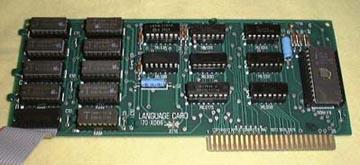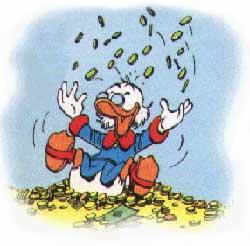Revolution in the Valley: The Insanely Great Story of How the Mac Was Made
Read Revolution in the Valley: The Insanely Great Story of How the Mac Was Made Online
Authors: Andy Hertzfeld
Tags: #Business & Economics, #General, #Industries, #Computers & Information Technology, #Workplace Culture, #Research & Development, #Computers, #Operating Systems, #Macintosh, #Hardware


I'll Be Your Best Friend
by Andy Hertzfeld in August 1979
Andy and Burrell in January 1983
Toward the end of my first week as an Apple employee in August 1979, I noticed that someone had left a black binder on my desk, with a hand-written title that read, "Apple II: Principles of Operation". It contained a brilliant, concise description of how the Apple II hardware worked, reverently explaining details of Woz's epic, creative design hacks, in a clearer fashion than I'd ever read before. I didn't know who left it there, but the title page said it was written by "Burrell C. Smith".
Later that day, in the late afternoon, I was approached by a young, animated, slightly nervous guy with long, straight, blond hair, who entered my cubicle and walked right up to me.
"Are you Andy Hertzfeld? Wow, it's amazing to meet you. I read your articles in Call A.P.P.L.E. and Dr. Dobb's. Apple's lucky they got you to work here. I want to shake your hand."
With exaggerated formality, he extended his right arm stiffly, almost in a parody of a handshake offer. "I'm Burrell. Burrell Carver Smith. Pleased to meet you. I wrote that manual I left on your desk.", he said, pointing to the black binder on my desk. We shook hands and then he suddenly turned around nervously and darted off, without explanation. "See you later!", he said, without looking back.
My cubicle in Bandley 1 was in the hardware engineering section, since my first project was writing the firmware for the Silentype thermal printer. It was across the aisle from Wendell Sander's office. Wendell was the designer of the Apple III and an extremely brilliant and seasoned engineer, who used to design RAM chips for Fairchild and understood the Apple II hardware design inside out. All the other hardware engineers on the team, except for Woz, usually came to Wendell for advice.
I began to notice that Burrell, even though he was supposed to be working in the service department in a different building, often hung around outside of Wendell's office, sometimes for hours at a time, waiting for Wendell to have a free moment, so he could ask him to verify his latest insight about the Apple II timings. Sometimes, when Wendell was busy, he would try the insight out on me instead, or discuss a fine point of the Apple II firmware. Soon, we started to occasionally go out for lunch together.
The first time we went to lunch, I found out that Burrell's creativity extended beyond his engineering work. He would often try to convince our waitress to concoct variations of the standard fare on the menu, thinking of something different every time.
For example, after he successfully persuaded a waitress to divide his pizza toppings into thirds, he asked her to do fifths the next time. Or he would sometimes try to order mixed sodas as if they were cocktails, in ever varying proportions, like three quarters Coke, and one quarter Sprite. Often, the waitress would balk but Burrell was sometimes charming enough to eventually convince her to comply. He would also obsess on certain foods, becoming fixated on Bulgarian Beef sandwiches from Vivi's for a while, and then a Pineapple Pizza phase (see
pineapple pizza
), evolving to his most enduring favorite, sushi, which provided a new range of interesting choices and combinations.
Burrell also had a distinctive way of expressing himself, applying technical jargon to ordinary life (like a situation that was "meta-stable", or someone being a "state machine"), mixed with a dash of baby talk (like adding plurals to people's names). An attractive woman was referred to as a "good prototype", or a "good proto" for short. Burrell had a great sense of humor and periodically performed hilarious impressions of everyone else on the team, caricaturing their personality quirks with an incisive phrase or nickname (see
i invented burrell
). He also liked to make fun of various language conventions; for example, if he was pleased with new software, he'd say "Happiness comma software".
One of his favorite expressions was "I'll be your best friend". He offered "best friendship" for a wide range of activities, like making some change in the software for him or getting him a Coke from the gas station. "Best friendship takes place", he would declare if pleased with the results. He also had a habit of reducing things to initials, like "B.F.R." for "Best Friendship Relationship".
Once, right after Burrell conferred best friendship upon me, I heard him offer best friendship to someone else, for a different favor. "Wait a second", I challenged Burrell, "How can you give out best friendship to someone else? There can be only one best friend at a time, can't there?"
Burrell had a quick reply, delivered with a smile. "Of course there can be only one "best" friend at a given instant of time. But best friendship relationships may be highly dynamic. The average length of a best friendship is three to five milliseconds. So there's no problem in having a new B.F.R. a second or two later."
We'll See About That
by Andy Hertzfeld in November 1979

Apple II Language Card
Burrell Smith was a 23 year old, self-taught engineer, without a college degree, who was drawn to Apple by the sheer elegance of the Apple II design. He was hired into Apple in February 1979, as Apple employee #282, a lowly service technician responsible for fixing broken Apple IIs that were sometimes returned by customers. As he debugged broken logic boards, sometimes more than a dozen in a single day, he began to develop a profound respect and empathy for Steve Wozniak's unique, creative design techniques.
Meanwhile, the Lisa team had been writing their first code in Pascal, running on Apple IIs, because the Lisa hardware wasn't ready yet. They had been at it for almost a year, and they had written more code than would fit in the 64 Kbytes of memory in a standard Apple II. In fact, the Apple II only had 48 Kbytes on its main board, but it used a "language" card to give it an extra 16 Kbytes used to run Pascal. To accomplish this, the language card had to "bank switch" its RAM over the ROM on the Apple II motherboard.
Bill Atkinson was the main programmer for both the Apple II Pascal system as well as the new Lisa system. He was in the service department picking up some extra language cards when Burrell heard him lamenting about overflowing the Apple II's memory limitations.
"Well, why don't you add more memory to the language card?", Burrell suggested.
Bill was intrigued, but he complained, "You can't add any more memory because we're out of address space. 64K is the limit of what we can address."
Burrell had already thought of that. "Well, the language card is already bank-switching the RAM, even double-banking the last 2K where the monitor ROM is. We'll just make it bank-switch another bank."
Bill was enthusiatic, so Burrell built him a prototype while Bill modified the Pascal run-time to support the extra bank switching. It worked like a charm, so soon Burrell was busy manufacturing 80K language cards for all the Lisa programmers.
Around this time, Bill ran into Jef Raskin. Jef had been writing a series of papers about a consumer-oriented computer that would be extremely inexpensive and radically easy to use. He was ready to start building a hardware prototype so he was looking for a talented hardware designer who could pull off his vision of a brutally simple, ultra low cost machine.
"I've got someone who you ought to meet", Bill told Jef. He made arrangements to bring Burrell over to Jef's house in Cupertino over the weekend.
Bill and Burrell showed up at Jef's house at the appointed time. Bill introduced Burrell to Jef, saying. "Jef, this is Burrell. He's the guy who's going to design your Macintosh for you."
"We'll see about that", Jef replied. "We'll see about that."
Scrooge McDuck
by Andy Hertzfeld in February 1980

this image is similar to the first
image ever displayed on a Macintosh
Burrell Smith liked to do intensive design work over the Christmas break, so the very first prototype of the very first Macintosh sprung to life early in the first month of the new decade, in January 1980. It wasn't really a stand-alone computer yet, as the prototype resided on an Apple II peripheral card, but it already contained the essential hardware elements of Jef Raskin's Macintosh dream: a Motorola 6809E microprocessor, 64K of memory, and a 256 by 256 bit-mapped graphic frame buffer, which was hooked up to a cute, tiny 7 inch black and white display. Burrell used the Apple II host to poke values into the memory of the prototype, so he could initialize the control registers and run small programs with the 6809.
I went out to lunch with Burrell a few weeks later and, knowing my appreciation for Woz-like hardware hacks, he explained the crazy way that he contrived for the Apple II to talk with the prototype. He didn't want to waste time designing and wiring up hardware to synchronize the memory of the two machines, since that wouldn't be needed by the real product. Instead, he delegated the memory synchronization to the software, requiring the Apple II to hit a special memory address to tell the prototype how many microseconds later to grab data off of the common data bus. It was weird enough to make me interested in seeing if it really worked.
By now, Burrell thought that he had the graphics running properly, but he wasn't really sure; he still needed to write some software to try it out. I told him that I'd look into it when I had some time. He gave me a copy of a handwritten page that contained the magic addresses that I'd have to use, hoping that I'd get around to it soon.

Burrell's DMA instructions
I was used to coming back to the lab at Apple after dinner, to see if anything interesting was going on and working on various extra-curricular projects. I had some spare time that night, so I got out Burrell's instructions and wrote an Apple II (6502) assembly language routine to do the necessary bit-twiddling to transfer whatever was on the Apple II's hi-res graphic display to the Mac prototype's frame-buffer, using Burrell's unusual synchronization scheme.